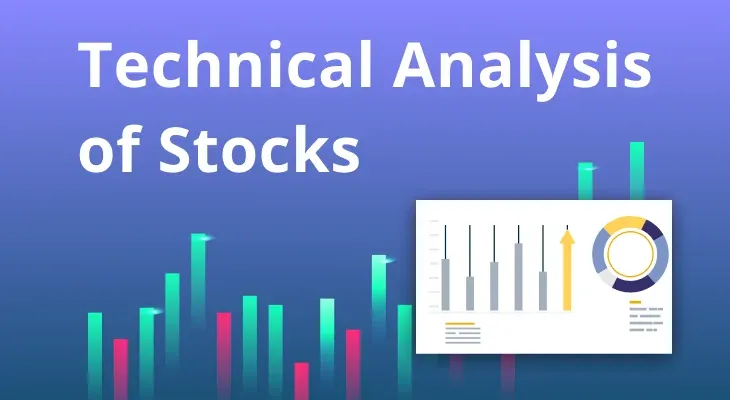
Technical Analysis of Stocks
Markets are driven by a variety of micro and macroeconomic factors, with supply and demand being one of the prominent ones. The price movements reflect the balance between buying and selling pressures. Technical analysis can help you, as an investor, identify key support and resistance levels, which are levels where buying or selling pressure may be particularly strong. The process of technical analysis involves the use of various indicators, such as moving averages, momentum indicators, and oscillators, to help identify trends and signals. Let us understand the importance of technical analysis and take a closer look at the techniques the process entails.
What is technical analysis?
Technical analysis of stocks is the study of stock price, volume data, and past market behaviour to identify trends, patterns, and signals. This information can help investors predict future price movements and make better trading decisions. Technical analysis deploys various principles, tools, and techniques to analyse market data and generate trading signals, as we shall see in the upcoming sections of this article.
Types of charts used in technical analysis of stocks
One of the key tools used in technical analysis is charts. Charts are graphical representations of the vital information that traders and analysts require to identify trends, patterns, and past performance – the stock’s price and volume data. There are several types of charts used in technical analysis, each with its own strengths and weaknesses. Here are some of the most popular ones.
Line Charts
The line chart is the most basic, yet very popular, type of chart used in the technical analysis of financial markets. It plots the closing prices of a company’s stock over a specified period of time as a continuous line. The line chart is useful for identifying long-term trends in a security's price. Line charts are often used in conjunction with other technical analysis tools to obtain a wider view of a security's price movements over time. They can be particularly useful for identifying trends and patterns in a security's price over the long term, as well as for providing a visual representation of the overall directional swing of the market – like bearish or bullish.
However, it does not provide much detail about the price movements within a given time period. Hence, you may need to use more detailed charts such as bar charts or candlestick charts. Nonetheless, line charts can still be a useful tool to get a quick, general sense of a security's price movements and overall trend.
Bar Charts
A bar chart is more detailed than a line chart and provides more information about the price movements of a stock. A typical bar chart shows the opening, high, low, and closing prices of a security for each time period in the form of vertical bars. While the top of the bar represents the highest price of the security during the said period, the bottom represents its lowest price. A horizontal line on the left side of the bar represents the opening price. while a horizontal line on the right side represents the closing price. The length of the bar indicates the range between the high and low prices.
Bar charts are useful for identifying short-term trends and patterns in a security's price. They can also be used to identify support and resistance levels, which are price levels where buying or selling pressure is particularly strong.
Candlestick Charts
Although candlestick charts are similar to bar charts, they provide more detail about the price movements of security and are widely used in technical analysis to identify trends and patterns in the price movements of securities.
Candlestick charts display the opening, high, low, and closing prices of a stock for each time period in the form of rectangular blocks called candlesticks. The top of the candlestick represents the highest price of the security during the time period, while the bottom of the candlestick represents the lowest price. The opening price is represented by a thin vertical line at the bottom of the candlestick, while the closing price is represented by a thin vertical line at the top of the candlestick.
The delta between the high and low prices in the assessment time period (the range) is denoted by the length of the candlestick. For example, a long white candlestick indicates that buyers are in control (bullish market), while a long black candlestick indicates that sellers are in control (bearish market).
[Read Also: Candlestick Patterns]
Support and Resistance
While charts will help you identify price movements and patterns, there are two important concepts in technical analysis – Support and Resistance – that can aid in determining the levels where buying or selling pressure is likely to be strong in the market. By watching for signs of a price reversal at these levels, you can make a more informed trading decision and manage your risk more effectively. To be able to use charts, trendlines, moving averages, and other indicators and tools effectively, you should know these concepts well.
Support
Support is a price level at which a security has historically found buying pressure that prevents the price from falling further. It is often seen as a "floor" below which the price of a security is unlikely to fall. Support levels can be used to identify potential entry points for buying a stock because they expect the price to bounce back up from the support level.
Resistance
On the other hand, resistance is the price level at which a security has historically found selling pressure, preventing the price from rising further. It is often seen as a "ceiling" above which the price of a security is unlikely to rise. Traders use resistance levels to identify potential entry points for selling security because they expect the price to fall back down from the resistance level.
In addition to identifying potential entry and exit points, support and resistance levels can also be used to manage risk. Traders can set stop-loss orders just below support levels or just above resistance levels to limit potential losses if the price breaks through these key levels.
Key benefits of using technical analysis
Now that you know the concept of technical analysis of the financial markets better, you can use it to make the right trading moves. Here are some of the key benefits of using technical analysis:
Identifying Trends
Technical analysis helps you identify trends in a security's price movements, which can provide insight into the market's overall direction, thereby, enabling you to make more informed decisions about when to enter or exit a position. It also facilitates more objective trading decisions based on data and analysis rather than emotions or biases.
Identifying Support And Resistance Levels
By identifying key levels of support and resistance in the market, you can set stop-loss orders or identify potential entry and exit points.
Providing Insight Into Market Sentiment
Technical analysis can provide insight into the overall sentiment of the market, which can be useful for predicting future price movements.
Facilitating Risk Management
Technical analysis can be used to manage risk by setting stop-loss orders or identifying key levels of support and resistance. This can help you limit your losses and protect your profits.
In conclusion, technical analysis of stocks is a valuable tool to help you make more informed trading decisions. By providing insight into trends, support and resistance levels, market sentiment, and risk management, technical analysis can help you identify profitable trading opportunities and manage your risks more effectively. If you are looking to increase your profitable trades, then the easiest way is to eliminate your brokerage outflow. How? Simply open m.Stock’s free Demat account and enjoy zero brokerage across equity delivery, mutual funds and IPOs. So, open an account now!
FAQ
What are the main types of technical analysis tools?
There are many different types of technical analysis tools, including charts, trendlines, moving averages, indicators, and oscillators. Each tool provides specific insights into market movements and can be used to make more informed trading decisions.
What are the benefits of technical analysis?
Technician analysis of stocks can help you gain valuable insights regarding the stock’s price movements and the general direction of the sector or the market on the whole. You will be able to identify profitable opportunities and optimum entry/exit points. It can also help you limit your risks and hedge your losses.
Can technical analysis be used by beginners?
Beginners can surely benefit from technical analysis of financial markets by identifying lucrative trading opportunities. However, it is important to take the time to learn about different technical analysis tools and how to use them effectively. It is also important to start with small trades and to constantly monitor market conditions.
What are the limitations of technical analysis?
Technical analysis has a few limitations that need to be kept in mind. For starters, it only takes into account price and volume data and does not consider fundamental factors such as earnings reports or economic data. In addition, past performance may not be indicative of future performance, and market conditions can change quickly. Therefore, it is important to use technical analysis in conjunction with other fundamental analysis tools and to regularly monitor market movements.


